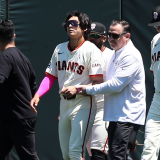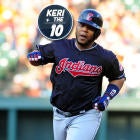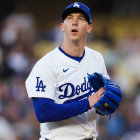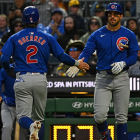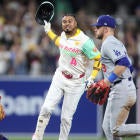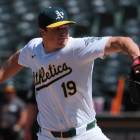 Welcome to this week's edition of Keri The 10! As always, we'll go around the majors with 10 stories that caught our eye from the past seven days. There will be numbers, and occasionally, memes. As always, we will have fun.
Welcome to this week's edition of Keri The 10! As always, we'll go around the majors with 10 stories that caught our eye from the past seven days. There will be numbers, and occasionally, memes. As always, we will have fun.
1. 'Edwing' is back, and so is Cleveland
The three-year, $60 million contract Cleveland gave Edwin Encarnacion looked like a steal from the moment it was signed. After all, Encarnacion and his agent reportedly sought $100 million in their first round of negotiations with the Blue Jays, and Edwing's price dropped severely after the Jays made him a take-it-or-leave-it offer that ended as leave-it-and-go-sign-the-poor-man's-version-of-Encarnacion instead. The lower number looked like a steal for a player who had bashed 42 homers in 2016, and averaged 39 bombs from 2012-16.
Thirty-five games into this season, the deal looked like anything but a bargain. Encarnacion was hitting .213, slugging .352 and striking out in more than one-third of his at-bats. Very much related: The Indians lost that day, their third straight setback dropping them to 18-17, two games back in the AL Central. If you were counting the biggest disappointments in the league to that point, both Encarnacion and the defending AL pennant winners would rank way up there.
Things have turned for the better since then. Cleveland has gone 21-15, surging to a 2 1/2-game lead in the Central -- as most people expected heading into this season. Meanwhile, Encarnacion has turned into one of the hottest and most potent power hitters in the league -- as most people expected heading into this season. Since deepening his woes with 0-fers on May 14-15, Encarnacion has batted a gigantic .330/.420/.696, crushing 12 homers and whiffing a far more reasonable 23 times in 112 at-bats. Encarnacion's huge bounceback underscores the risk of panicking over small sample sizes: After not hitting a lick for six weeks, Encarnacion is now hitting at a rate that's 32 percent better than league average (adjusted for park factors). The 42-homer, 127-RBI 2016 campaign that earned him his big contract? 34 percent better than league average.
Things figure to improve in Cleveland. Michael Brantley, already providing a big .296/.360/.432 lift after missing most of last season with a shoulder injury, should return this weekend or soon afterwards from a fairly minor ankle ailment. Talented but erratic right-hander Danny Salazar is throwing off a mound again after hitting the DL with a shoulder injury June 4, and young righty Mike Clevinger has done well in Salazar's absence, whiffing 28.4 percent of the batters he has faced. Big performances by superutility star Jose Ramirez and rookie outfielder Bradley Zimmer have bolstered what was an already loaded roster heading into 2017.
In short, the Indians are back to where a team with this much talent should be. They're the odds-on favorites to repeat as AL Central champs.
2. Faria on fire
The 2016 season was a disaster for the Rays. Bogged down by injuries and horrendous results in high-leverage situations (27th in the majors in clustering hits together on offense last year), Tampa Bay lost 94 games, the team's worst showing in nine years and second worst in the American League last season.
The Rays are suffering from even worse luck in the hit-clustering department this year, with the offense failing to produce in big spots and pitchers ending up with crooked numbers due partly to an inability to scatter hits across multiple innings. Still, the overall results look much, much better: Tampa Bay has climbed to 39-36, and currently leads in the race for the AL's second wild-card. The emergence of Corey Dickerson and Logan Morrison has fueled an offense that shockingly ranks second in the majors in home runs, despite toiling in a home ballpark that perennially suppresses power.
The pitching staff has received a big boost of its own, from rookie Jacob Faria. The 23-year-old right-hander has thrived in his first three big-league starts, going 6 1/3, 6 1/3 and 7 innings while allowing just one run in each. He's also still striking out gobs of hitters, with 22 in those 19 2/3 innings (and no home runs allowed). The question here is, can the good times last? Both for Faria, and by extension, for the Rays?
Faria has been one of the most prolific strikeout artists in pro ball since 2015, punching out 31.9 percent of the batters he faced at Double-A in 2015, 27 percent of Double-A batters when he returned to that level to start the 2016 season, then a huge 34.7 percent of the batters he opposed in 58 2/3 innings at Triple-A this year. But despite those gaudy K rates, prospect hounds were never giddy about his future. Baseball America ranked Faria as just the eighth-best prospect in a farm system considered by prospect pundits to be middle of the pack at best. Baseball America praised Faria's changeup and his ability to throw it in any count ... but also warned that he has just "passable control." Then there was this: "Faria's stuff isn't explosive. His game is founded upon his deception and downhill angle. His fastball works at 89-92 mph and will occasionally reach as high as 94."
It's possible that teams will study the scouting reports, pick up on Faria's deception, draw a bunch of walks and start raking against him. On the other hand, scouts (like statheads) have been wrong too many times to count when it comes to projecting pitcher performance. If Faria can keep parlaying his low-90s fastball, wicked change and unpredictable approach into more successful outings, a mini-version of the Rays 2007-08 worst-to-first run (worst-to-wild card?) can't be ruled out.
Does this look like a rookie to you? pic.twitter.com/reJEZYIXY6
— Tampa Bay Rays (@RaysBaseball) June 19, 2017
3. Alex Gordon hangs Jason Vargas out to dry
I have no idea what's going on here. I don't know why Alex Gordon celebrated a recent home run by high-fiving everyone on the team, before snubbing Jason Vargas at the end -- especially in a season in which Gordon's hitting like a pitcher and Vargas is suddenly pitching like an ace.
All I know are two things. One, the Royals are the vampires of baseball, impossible to kill (and back in a playoff race) just when it looked like they were dead and buried. And two, this is a phenomenal GIF.
Got it in gif form pic.twitter.com/UuMBBB2d2E
— Bellwether Johnson (@BWetherJohnson) June 18, 2017
4. U Mad?
It's nearly impossible to believe during a season in which Clayton Kershaw ha stayed healthy all the way through, but Mad Max Scherzer is building an excellent case for a second straight NL Cy Young. A glance at his Baseball-Reference page reveals a whole lot of bolded stat lines, indicating best-in-the-league status. Scherzer currently leads the NL in every durability category (starts, innings pitched, batters faced and complete games), as well as strikeouts, hit rate, ERA and Fielding Independent Pitching.
As great as those numbers look, they don't do justice to the incomprehensible streak Scherzer is on right now. Here's what he has done in his past six starts: 48 IP, 69 K, 8 BB, 20 H, 0.94 ERA, 73 percent strike percentage, opponents batting .123/.189/.204. With 10 or more strikeouts in six straight starts, he's closing in on the all-time record of eight such games, achieved three times -- once by Pedro Martinez, and twice by Chris Sale, with the most recent such feat happening earlier this season.
Kershaw's long run of dominance ensures that he retains the title of best pitcher on Earth for now. But at the very least, Scherzer (and Sale!) offer possible contenders to the throne. I mean ... look at this dude.
Max Scherzer, Practicing Holds, Pregame. pic.twitter.com/pgt55JZdGT
— Rob Friedman (@PitchingNinja) June 22, 2017
5. Can we get a mulligan on that one?
In the 2015 playoffs, Daniel Murphy turned into a one-man wrecking crew. Always a capable hitter with an excellent batting eye, Murphy suddenly turned into an MVP-caliber performer, smashing seven homers in his first nine games of that postseason. The Mets didn't prevail in that year's World Series, thanks in part to Murphy going cold in the Fall Classic. Still, with the benefit of hindsight we can now see that Murphy was an early adopter of the strategy that has swept through baseball and made stars out of many unlikely candidates: Swing hard, and hit the ball in the air.
The Mets clearly didn't see the change coming, because they let Murphy go at the end of that season. The three-year, $37.5 million deal the Nationals gave Murphy that winter now looks like one of the most team-friendly free-agent contracts in recent baseball history.
As if losing a key player to an arch divisional rival then watching him become a star as soon as leaves isn't bad enough, Murphy has turned into Ted Williams against his former team. Sunday marked Murphy's 29th game against the Mets since leaving. He has reached base in every single one of those 29 games, and is hitting an obscene .391/.441/.704. Yikes.
6. When a problem comes along ...
I've already professed my love for Chris Devenski round these parts. The changeup-slinging strikeout monster has been incredible for the Astros this season, dominating opponents and turning back the clock on relief pitcher usage, with multiple outings lasting four innings or longer.
Now, Astros fans have pushed that love to another level. Seizing on Devenski's nickname, Minute Maid Park has started filling up with fans clad in funky red hats, the kind once worn by 1970s and '80s new-wave band Devo. It's nothing short of glorious.
A bunch of @Astros fans wore Devo hats in support of pitcher @ddddeevvvoooo. https://t.co/Mr18xH66Fj pic.twitter.com/BBa3OwCGnj
— Cut4 (@Cut4) June 13, 2017
7. Tyler Scary
In losing eight of their past nine games and falling back into a virtual tie for first place in the AL East, the Yankees have seen several flaws exposed. Both first base and third base have become untenable, with Chris Carter and Chase Headley becoming replacement-level players and would-be replacements Greg Bird and Gleyber Torres knocked out by injuries (in Torres' case for the rest of the season).
Still, one player has worn the goat horns for a huge chunk of this recent slide: Tyler Clippard. Opponents have scored in four of their past five cracks at the veteran Yankees setup man, with Clippard surrendering seven runs on seven hits in his past 2 2/3 innings pitched. Bullpen woes like those are how a team goes 9-11 in a given month (like, say, the Yankees in June), despite outscoring the opposition by 46 runs. Opponents are now slugging .586 against Clippard in close and late situations; in tie games, they're batting .263/.417/.579 against him.
This situation might not have grown so dire if Aroldis Chapman's injury hadn't scrambled Joe Girardi's brain. Girardi shifted Dellin Betances to the closer role while Chapman healed, and the Yankees skipper has seemed reluctant to use Betances in earlier-game, high-leverage situations since, even after Chapman got back on the mound. Heading into Wednesday's game, Girardi had used Betances only four times all month, a situation that's inexcusable even acknowledging Chapman just returned Sunday, and the Yanks blowing out a bunch of teams this season. Girardi did subsequently use Betances in back-to-back games Wednesday and Thursday, and now you wonder if he might put the kid gloves back on, after Betances got touched for two runs in a game-deciding seventh inning Thursday against the Angels.
The Yankees shouldn't regret last summer's Andrew Miller trade, considering the haul of young talent they got in return and the longer-term timetable that seemed necessary to elapse before they could become true contenders again. Now that they're ahead of schedule, though, they surely miss having a multi-inning nuclear weapon to bridge the gap from the starters to the back of the pen. If the Yanks do want to make a real run at the division crown this year, they'll almost certainly want to shop for a reliever who can fill something close to that role. At this stage, a poor man's Andrew Miller would still be a rich man's Tyler Clippard.
8. Miggy, just having fun out there
Yes, injuries have sapped Miguel Cabrera's power this season, limiting him to a fairly pedestrian .267/.368/.433 line, with just seven home runs in 59 games. Still, a decade and a half after breaking into the majors as a precious 20-year-old, Cabrera might still more closely resemble a kid on the field than any other player in the game today.
Miggy is the best. This happened at Safeco when a foul ball went out of reach. Hilarious. pic.twitter.com/HqiHElNmc6
— Maury Brown (@BizballMaury) June 22, 2017
9. Sensational Southpaw
One of the biggest breakout pitchers in the league, and one of the biggest reasons for the Diamondbacks' surprising success this season, has been Robbie Ray. The 25-year-old left-hander ranks second in the National League in park-adjusted ERA and second in strikeout rate, emerging as one of several pitching success stories under the new D-Backs regime, which includes recently retired major-league pitchers Dan Haren (now Arizona's pitching strategist) and Burke Badenhop (now a baseball ops analyst).
For more on Ray's 2017 dominance, we turn to our pal Nick Pollack, the excellent analyst at PitcherList.com:
Let's begin with the pitch that put Ray on the map: his slider. That's the pitch that has made Ray a strikeout machine through the years and has held a whiff rate above 20 percent in each of the last two years. Batters make contact with the pitch less than 60 percent of the time and the breaking ball is simply untouchable when Ray spots it under the zone. All of the numbers line up compared to previous seasons except for his HR/FB rate, which has plummeted from a ghastly 27.8 percent to just 6.3 percent in 2017. This is a product of his altered approach for the pitch, dropping its zone rate from the mid-30s to just 25.9 percent in 2017, preying on batters who chase it under the strike zone. It can be incredibly difficult to lay off the pitch:
With his slider usage nearly identical to 2016, Ray has made alterations to the rest of his arsenal in 2017. His two-seamer and changeup were far and away his worst pitches in 2016. He has lowered his usage rate on both offerings this season, dropping his two-seamer usage from 16.1 percent to 7.4 percent and removing his changeup almost entirely from the equation with just a 1 percent thrown rate so far. Instead, Ray has introduced a curveball that is doing a superb job as the third pitch Ray has desperately needed. He's throwing the pitch both as a strike early in counts and as a way to get batters to chase out of the zone. Instead of throwing a changeup that resulted in a strike or ball in play just 51 percent of the time in 2016, he's now throwing a curveball that gets the desired result 61 percent of the time. That's a dramatic swing that has allowed Ray to be more on the attack. Additionally, two-seamers and changeups rendered whiffs about 8.3 percent of the time in 2016. Ray's curveball is more than doubling that number this season with a 17.1 percent mark. Here's the pitch in action and you'll quickly see why its 7.3 Pitch Value is the highest of any curveball in the majors:
Then there is his four-seamer, which had a 9.3 percent whiff rate last season. Now that he's throwing fewer two-seamers, it would be expected for its whiff rate to decline -- fastballs aren't supposed to have high whiff rates as you need to throw them for strikes constantly. However, Ray has increased the pitch's whiff rate to an impressive 10.2 percent mark; that's a product not of command but rather having two secondary pitches he trusts in deep counts. Now that Ray is throwing curveballs and sliders when behind left-handers, the fastball becomes more of a surprise when it's thrown with two strikes, leading to a bump in strikeout rate to 31.9 percent -- a startlingly high number for a pitch thrown more than 50 percent of the time.
Ray can still be wild at times, with his 11 percent walk rate third highest among all NL starters this season. But the introduction of his curveball combined with varied usage of his fastball, plus some better luck on balls in play (especially fly balls) has produced an elite lefty who has played a huge role in an unexpected development in the desert: the best rotation in all of baseball.
10. Burning Question of the Week
Is bunting to break up a no-hitter breaking an unwritten rule? #KeriThe10
— Breslin Birds (@BreslinBirds) June 22, 2017
While Jarrod Dyson's bunt Wednesday to break up Justin Verlander's no-hitter did elicit clucks of disdain from some traditionalists, Verlander himself had no problem with the move.
Verlander yesterday on Dysons bunt. pic.twitter.com/DHzotbYQwZ
— Clutchsilver (@clutchsilver) June 22, 2017
More broadly, though, baseball's unwritten rules should be blasted into the sun. While other sports revel in their fun and spontaneity, baseball players never seem to go more than a day or two without looking incredibly thin-skinned. The Mets getting agitated over Yasiel Puig pimping a home run this week was just the latest example of the sport's bizarre fixation with decorum.
Don't want to get shown up by a triumphant opponent? Try to suck less. It's not that hard.
Tweet Jonah using #KeriThe10 to have a chance to have your question answered here.







